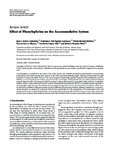Effect of Phenylephrine on the Accommodative System.
| dc.contributor.author | Esteve-Taboada, JJ | en |
| dc.contributor.author | Del Águila-Carrasco, AJ | en |
| dc.contributor.author | Bernal-Molina, P | en |
| dc.contributor.author | Ferrer-Blasco, T | en |
| dc.contributor.author | López-Gil, N | en |
| dc.contributor.author | Montés-Micó, R | en |
| dc.date.accessioned | 2018-09-20T17:48:05Z | |
| dc.date.available | 2018-09-20T17:48:05Z | |
| dc.date.issued | 2016 | en |
| dc.identifier.issn | 2090-004X | en |
| dc.identifier.uri | http://hdl.handle.net/10026.1/12400 | |
| dc.description.abstract |
Accommodation is controlled by the action of the ciliary muscle and mediated primarily by parasympathetic input through postganglionic fibers that originate from neurons in the ciliary and pterygopalatine ganglia. During accommodation the pupil constricts to increase the depth of focus of the eye and improve retinal image quality. Researchers have traditionally faced the challenge of measuring the accommodative properties of the eye through a small pupil and thus have relied on pharmacological agents to dilate the pupil. Achieving pupil dilation (mydriasis) without affecting the accommodative ability of the eye (cycloplegia) could be useful in many clinical and research contexts. Phenylephrine hydrochloride (PHCl) is a sympathomimetic agent that is used clinically to dilate the pupil. Nevertheless, first investigations suggested some loss of functional accommodation in the human eye after PHCl instillation. Subsequent studies, based on different measurement procedures, obtained contradictory conclusions, causing therefore an unexpected controversy that has been spread almost to the present days. This manuscript reviews and summarizes the main research studies that have been performed to analyze the effect of PHCl on the accommodative system and provides clear conclusions that could help clinicians know the real effects of PHCl on the accommodative system of the human eye. | en |
| dc.format.extent | 7968918 - ? | en |
| dc.language | eng | en |
| dc.language.iso | eng | en |
| dc.title | Effect of Phenylephrine on the Accommodative System. | en |
| dc.type | Journal Article | |
| plymouth.author-url | https://www.ncbi.nlm.nih.gov/pubmed/28053778 | en |
| plymouth.volume | 2016 | en |
| plymouth.publication-status | Published | en |
| plymouth.journal | J Ophthalmol | en |
| dc.identifier.doi | 10.1155/2016/7968918 | en |
| plymouth.organisational-group | /Plymouth | |
| plymouth.organisational-group | /Plymouth/Faculty of Health | |
| plymouth.organisational-group | /Plymouth/Faculty of Health/School of Health Professions | |
| plymouth.organisational-group | /Plymouth/REF 2021 Researchers by UoA | |
| plymouth.organisational-group | /Plymouth/REF 2021 Researchers by UoA/UoA03 Allied Health Professions, Dentistry, Nursing and Pharmacy | |
| plymouth.organisational-group | /Plymouth/Users by role | |
| plymouth.organisational-group | /Plymouth/Users by role/Academics | |
| dc.publisher.place | United States | en |
| dcterms.dateAccepted | 2016-10-26 | en |
| dc.rights.embargoperiod | Not known | en |
| rioxxterms.versionofrecord | 10.1155/2016/7968918 | en |
| rioxxterms.licenseref.uri | http://www.rioxx.net/licenses/all-rights-reserved | en |
| rioxxterms.licenseref.startdate | 2016 | en |
| rioxxterms.type | Journal Article/Review | en |


